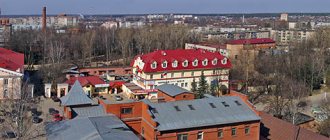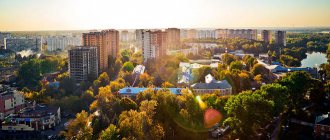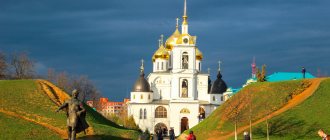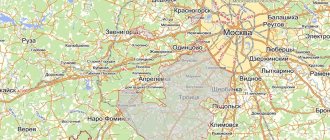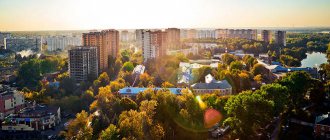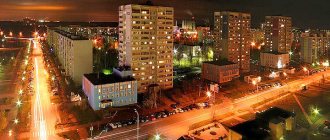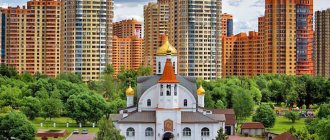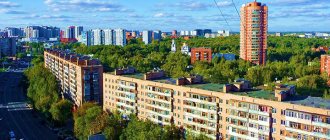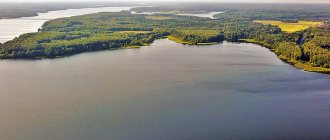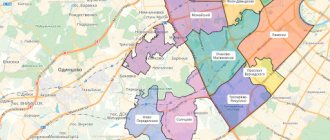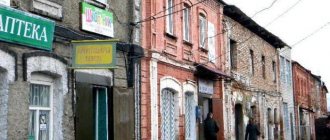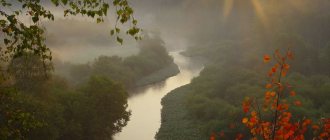Bolshiye Vyazemy is an estate with a unique, almost 500-year history. It was first mentioned in a chronicle of the 16th century. At that time, the last station near Moscow on the old Smolensk road was located here. The village located here was called Nikolskoye-Vyazemy.
View of the estate from the park, © Anna Abrosimova
General information about the city and a little history
The history of the appearance of the city is connected with the construction of the Moscow-Smolensk-Brest railway in the second half of the 19th century.
In 1872, at 41 versts, the Golitsynskaya station appeared - a wooden two-story building, a platform and several houses for service personnel - it became the beginning of a new village. The name was given in honor of the princely family - the Golitsyns, whose estate was located not far from the station. The lands belonging to the prince were actually divided by the railway, and at the dawn of the 19th century the owner decided to build a demonstration holiday village with the goal of selling the plots profitably in the future. The territory of the village south of the railway is cut through by 13 avenues, driveways and highways, and the village itself receives the name Golitsynsky town.
In the 1930s, Soviet writers chose Golitsyno as a place of creativity. In 1932, the small two-story house of F.A. Korsh was transferred to the Literary Fund and became the “house of creativity of the Writers’ Union.” Here, over the years, M. Aliger, K. Paustovsky, M. Shaginyan, A. Malyshkin, A. Gaidar, Musa Jalil, Mate Zalka, K. Trenev, A. Fadeev, A. Tvardovsky, V. Kataev rested and created their works. , E. Kazakevich. Anton Makarenko spent the last days of his life here. In the summer of 1937, after returning from emigration, the famous Russian writer Alexander Ivanovich Kuprin lived here. In the autumn of 1939 and winter of 1940, after a seventeen-year separation from her homeland, Marina Tsvetaeva lived in a room at one of the dachas in Golitsyn with her son Georgy. In Golitsyno there was a dacha of the poet and translator Arseny Tarkovsky.
In the post-war years, Golitsyno became a major industrial point. In 1949, the station was reconstructed and the railway tracks were electrified. In the fifties, a ceramic factory was created on the site of the seasonal fishing artel “Zvenigorodsky Trud”, which existed since 1928. Instead of an artel where toys, musical instruments, buttons and brooches were made, a hat factory arose.
Station, circa 1957
The first multi-storey buildings appeared in the village only in the 60s.
In 1972, the Higher Military-Political School of Border Troops of the KGB of the USSR was created on the territory of the village of Golitsyn, now it is the Golitsyn Border Institute of the FSB of Russia, one of the largest military universities in Russia.
By decree of the Governor of the Moscow Region dated September 9, 2004, the urban-type settlement of Golitsyno received the status of a city.
Golitsyno is located west of Moscow, at a distance of approximately thirty kilometers from the Moscow Ring Road. A highway known as the “Small Moscow Ring” runs along the northern outskirts of the city, and the Vyazemka River flows in the eastern part. The easiest way to get to the regional center - Odintsovo or Moscow - is by rail; trains run frequently; travel time to the center of Moscow is about 1 hour.
Museum-Reserve of A. S. Pushkin
Nowadays, Bolshie Vyazemy is part of the State Historical and Literary Museum-Reserve named after A. S. Pushkin.
Pushkin in Bolshie Vyazemy
Not far from the estate is Zakharovo, the estate of Alexander Sergeevich Pushkin’s grandmother, Marina Alekseevna. From 1805 to 1830, his family periodically visited Vyazemy for church services. Here, at the Transfiguration Church, is the grave of Alexander’s brother, Nicholas.
It was at a ball organized by Prince Golitsyn in his estate that Pushkin met Natalya Goncharova.
© vladkonst
The Golitsyn estate inspired the poet. It is believed that Alexander Sergeevich used Bolshie Vyazemy when describing the estate of Eugene Onegin. Princess Natalya Petrovna Golitsyna, who is considered the prototype of the Queen of Spades, also appeared at the estate.
Climate and ecology
The climate is “temperate continental”, winters are relatively mild, there are frequent thaws and melting snow underfoot.
Christmas tree on the station square. Photo by A. Zimin
The ecological situation in the city is good. The main sources of pollution are the Ceramic Plant, which has been operating at half capacity for the last decade, and vehicles.
An excerpt characterizing Golitsyno
“I came to you with an order and a proposal, Count,” he told him without sitting down. – A person very highly placed in our brotherhood petitioned for you to be accepted into the brotherhood ahead of schedule, and invited me to be your guarantor. I consider it a sacred duty to fulfill the will of this person. Would you like to join the brotherhood of free stonemasons on my guarantee? The cold and stern tone of the man whom Pierre almost always saw at balls with an amiable smile, in the company of the most brilliant women, struck Pierre. “Yes, I wish,” said Pierre. Villarsky bowed his head. “One more question, Count,” he said, to which I ask you not as a future Freemason, but as an honest man (galant homme) to answer me with all sincerity: have you renounced your previous convictions, do you believe in God? Pierre thought about it. “Yes... yes, I believe in God,” he said. “In that case...” Villarsky began, but Pierre interrupted him. “Yes, I believe in God,” he said again. “In that case, we can go,” said Villarsky. - My carriage is at your service. Villarsky was silent the whole way. To Pierre's questions about what he needed to do and how to answer, Villarsky only said that brothers more worthy of him would test him, and that Pierre needed nothing more than to tell the truth. Having entered the gate of a large house where the lodge was located, and walking along a dark staircase, they entered a lighted, small hallway, where, without the help of a servant, they took off their fur coats. From the hall they went into another room. Some man in a strange attire appeared at the door. Villarsky, coming out to meet him, said something quietly to him in French and went to a small closet, in which Pierre noticed clothes he had never seen before. Taking a handkerchief from the closet, Villarsky placed it over Pierre's eyes and tied it in a knot from behind, painfully catching his hair in the knot. Then he bent him towards him, kissed him and, taking him by the hand, led him somewhere. Pierre was in pain from the hair being pulled in by the knot; he winced in pain and smiled from shame for something. His huge figure with his arms down, with a wrinkled and smiling face, moved with uncertain timid steps behind Villarsky. After walking him ten steps, Villarsky stopped. “No matter what happens to you,” he said, “you must endure everything with courage if you firmly decide to join our brotherhood.” (Pierre answered in the affirmative by bowing his head.) When you hear a knock on the door, you will untie your eyes,” Villarsky added; – I wish you courage and success. And, shaking Pierre’s hand, Villarsky left. Left alone, Pierre continued to smile the same way. Once or twice he shrugged his shoulders, raised his hand to the handkerchief, as if wanting to take it off, and lowered it again. The five minutes he spent with his eyes tied seemed like an hour. His hands were swollen, his legs were giving way; he thought he was tired. He experienced the most complex and varied feelings. He was afraid of what would happen to him, and even more afraid of not showing fear. He was curious to know what would happen to him, what would be revealed to him; but most of all he was joyful that the moment had come when he would finally embark on that path of renewal and actively virtuous life, which he had dreamed of since his meeting with Osip Alekseevich. Strong knocks were heard on the door. Pierre took off the bandage and looked around him. The room was black and dark: only in one place was a lamp burning, in something white. Pierre came closer and saw that the lamp stood on a black table, on which lay one open book. The book was the Gospel; that white thing in which the lamp was burning was a human skull with its holes and teeth. Having read the first words of the Gospel: “In the beginning was the word and the word was to God,” Pierre walked around the table and saw a large open box filled with something. It was a coffin with bones. He was not at all surprised by what he saw. Hoping to enter into a completely new life, completely different from the previous one, he expected everything extraordinary, even more extraordinary than what he saw. The skull, the coffin, the Gospel - it seemed to him that he expected all this, expected even more. Trying to evoke a feeling of tenderness in himself, he looked around him. “God, death, love, brotherhood of people,” he said to himself, associating with these words vague but joyful ideas of something. The door opened and someone entered. In the dim light, which Pierre had already managed to take a closer look at, a short man entered. Apparently entering the darkness from the light, this man stopped; then, with careful steps, he moved towards the table and placed his small hands, covered with leather gloves, on it. This short man was dressed in a white leather apron that covered his chest and part of his legs, he had something like a necklace on his neck, and from behind the necklace protruded a tall, white frill that framed his elongated face, lit from below. – Why did you come here? - asked the newcomer, following the rustle made by Pierre, turning in his direction. - Why do you, who do not believe in the truths of the light and do not see the light, why did you come here, what do you want from us? Wisdom, virtue, enlightenment? At that moment the door opened and an unknown man entered, Pierre experienced a feeling of fear and reverence, similar to the one he experienced in confession as a child: he felt face to face with a complete stranger in terms of living conditions and with someone close to him, in the brotherhood of people, person. Pierre, with a breathless heartbeat, moved towards the rhetorician (that was the name in Freemasonry for the brother who prepares the seeker for entry into the brotherhood). Pierre, coming closer, recognized in the rhetorician a familiar person, Smolyaninov, but it was insulting to him to think that the person who entered was a familiar person: the person who entered was only a brother and a virtuous mentor. Pierre could not utter the words for a long time, so the rhetorician had to repeat his question. “Yes, I... I... want an update,” Pierre said with difficulty. “Okay,” said Smolyaninov, and immediately continued: “Do you have any idea about the means by which our holy order will help you achieve your goal?...” said the rhetorician calmly and quickly. “I... hope... guidance... help... in renewal,” said Pierre with a trembling voice and difficulty in speaking, arising both from excitement and from the unfamiliarity of speaking in Russian about abstract subjects. – What concept do you have about Freemasonry? – I mean that Frank Freemasonry is a fraterienité [brotherhood]; and the equality of people with virtuous goals,” said Pierre, ashamed as he spoke of the inconsistency of his words with the solemnity of the moment. I mean... “Okay,” the rhetorician said hastily, apparently quite satisfied with this answer. – Have you been looking for means to achieve your goal in religion? “No, I considered it unfair and did not follow it,” Pierre said so quietly that the rhetorician did not hear him and asked what he was saying. “I was an atheist,” answered Pierre. – You are looking for truth in order to follow its laws in life; therefore, you are seeking wisdom and virtue, are you not? - said the rhetorician after a minute of silence. “Yes, yes,” Pierre confirmed. The rhetorician cleared his throat, folded his gloved hands on his chest and began to speak: “Now I must reveal to you the main goal of our order,” he said, “and if this goal coincides with yours, then you will profitably join our brotherhood.” The first most important goal and overall foundation of our order, on which it is established, and which no human power can overthrow, is the preservation and transmission to posterity of some important sacrament... from the most ancient centuries and even from the first man who came down to us, from whom the sacraments can perhaps, the fate of the human race depends. But since this sacrament is of such a nature that no one can know it or use it unless one has prepared oneself through long-term and diligent purification, not everyone can hope to find it soon. Therefore, we have a second goal, which is to prepare our members as much as possible, correct their hearts, purify and enlighten their minds with those means that have been revealed to us by tradition from men who have labored in seeking this sacrament, and thereby make them capable of the perception of it. By purifying and correcting our members, we try, thirdly, to correct the entire human race, offering it in our members an example of piety and virtue, and thereby trying with all our might to resist the evil that reigns in the world. Think about this, and I will come to you again,” he said and left the room. “To resist the evil that reigns in the world...” Pierre repeated, and he imagined his future activities in this field. He imagined the same people as he himself was two weeks ago, and he mentally addressed them with an instructive and mentoring speech. He imagined vicious and unhappy people whom he helped in word and deed; imagined the oppressors from whom he saved their victims. Of the three goals named by the rhetorician, this last one - the correction of the human race - was especially close to Pierre. Some important sacrament mentioned by the rhetorician, although it incited his curiosity, did not seem significant to him; and the second goal, cleansing and correcting himself, occupied him little, because at that moment he felt with pleasure that he was already completely corrected from his previous vices and ready for only one good thing. Half an hour later, the rhetorician returned to convey to the seeker those seven virtues corresponding to the seven steps of the Temple of Solomon, which every Mason had to cultivate in himself. These virtues were: 1) modesty, respect for the secrets of the order, 2) obedience to the highest ranks of the order, 3) good morals, 4) love of humanity, 5) courage, 6) generosity and 7) love of death. “Seventhly, try,” said the rhetorician, “by frequently thinking about death to bring yourself to the point that it no longer seems to you a terrible enemy, but a friend... who frees the languishing soul from this miserable life in the works of virtue, to introduce it to a place of reward and calm. “Yes, this must be so,” thought Pierre, when after these words the rhetorician left him again, leaving him to solitary reflection. “This should be so, but I am still so weak that I love my life, the meaning of which is only now gradually revealed to me.” But the other five virtues, which Pierre remembered as he fingered them, he felt in his soul: courage, generosity, kindness, love for humanity, and especially obedience, which did not even seem to him to be a virtue, but happiness. (He was so happy now to get rid of his arbitrariness and subordinate his will to those and those who knew the undoubted truth.) Pierre forgot the seventh virtue and could not remember it. The third time, the rhetorician returned quickly and asked Pierre if he was still firm in his intention, and whether he dared to subject himself to everything that was required of him. “I’m ready for anything,” said Pierre. “I must also tell you,” said the rhetorician, “that our order teaches its teaching not only in words, but by other means, which, perhaps, have a stronger effect on the true seeker of wisdom and virtue than verbal explanations alone.” This temple, with its decoration, which you see, should have already explained to your heart, if it is sincere, more than words; You will see, perhaps, with your further acceptance, a similar image of explanation. Our Order imitates ancient societies that revealed their teachings in hieroglyphs. A hieroglyph, said the rhetorician, is the name of some thing not subject to feelings, which contains qualities similar to the one depicted. Pierre knew very well what a hieroglyph was, but did not dare to speak. He listened silently to the rhetorician, feeling from everything that the tests would begin immediately. “If you are firm, then I must begin to introduce you,” said the rhetorician, approaching Pierre closer. “As a sign of generosity, I ask you to give me all your precious things.” “But I have nothing with me,” said Pierre, who believed that they were demanding that he give up everything he had. - What you have on: watches, money, rings... Pierre hastily took out his wallet, watch, and for a long time could not remove the wedding ring from his fat finger. When this was done, the Mason said: “As a sign of obedience, I ask you to undress.” - Pierre took off his tailcoat, vest and left boot as directed by the rhetorician. The Mason opened the shirt on his left chest, and, bending down, lifted his trouser leg on his left leg above the knee. Pierre hastily wanted to take off his right boot and roll up his trousers in order to save a stranger from this labor, but the Mason told him that this was not necessary - and handed him a shoe on his left foot. With a childish smile of modesty, doubt and self-mockery, which appeared on his face against his will, Pierre stood with his arms down and legs apart in front of his brother the rhetorician, awaiting his new orders. “And finally, as a sign of sincerity, I ask you to reveal to me your main passion,” he said. - My passion! I had so many,” Pierre said. “That passion which, more than any other, made you hesitate on the path of virtue,” said the Mason. Pierre paused, searching. "Wine? Consolidation? Idleness? Laziness? Hotness? Anger? Women?" He went over his vices, mentally weighing them and not knowing which one to give priority to. “Women,” Pierre said in a quiet, barely audible voice. The Mason did not move or speak for a long time after this answer. Finally he moved towards Pierre, took the handkerchief lying on the table and again blindfolded him. – For the last time I tell you: turn all your attention to yourself, put chains on your feelings and look for bliss not in passions, but in your heart. The source of bliss is not outside, but within us...
Districts and real estate
Conventionally, Golitsino can be divided into four districts: “Nines”, “Keramika”, DRSU-4 and the private sector in the southern part of the city (the same Golitsyn town).
Map of Golitsyno districts
It should be noted that the city is still divided into two parts by the railway. There is no transport from one to the other, there is only one pedestrian bridge in the station area and “people's paths” across the railway tracks.
“Nines” is the youngest district, located in the northern part of the city. The first houses began to be built in the 70s and were nine stories high, hence the name. It is considered more favorable for living, since the station is located within walking distance of 5-10 minutes, and most residents work in neighboring cities. Also, the “nines” have their own kindergarten, school, clinic, banks, post office, shops and other conditions for a comfortable life. It is in the “nines” that the “Molodezhny” district is being built, where, at the very least, people from the old housing stock are being resettled.
Keramika was actively built up in the 60s, mainly with five-story buildings. The housing stock leaves much to be desired. The area is considered quite criminal. It is located 1.5 km from the station, you can get there by minibus or on foot, which is very risky, because... you have to go through the private sector, industrial enterprises or along railway lines, and the roads do not have sufficient lighting everywhere. In the area there are 2 kindergartens, a school, shops, and a gym. There is a large forest area on the border of the area.
View from Keramiki to Nyatki
DRSU-4 - southern outskirts of Golitsyno, old two-story houses built in the 50-60s. It does not have any infrastructure of its own; it is separated from Golitsyno station by private households.
South side of Golitsyno. Photo by Sasha Kallistova
Real estate in Golitsyno is expensive. In the northern part, a square meter on the secondary market costs around 100 thousand rubles, the primary one is much cheaper, about 80 thousand rubles. The southern part of the city is cheaper, as mentioned above, due to its distance from the station and older housing stock. Prices for two-room Khrushchev apartments there start at 3.5 million rubles.
What to see
Now the Boris Godunov Museum is located in the recreated stable building. In it you can see costumes from the opera Boris Godunov and archaeological finds discovered on the site of a burnt wooden tower.
You can visit the Transfiguration Church, the Palace of the Estate, the Boris Godunov Museum, the Eastern and Western wings. You can stroll through the park, which was planted in 1771, just when both outbuildings were being built.
Outbuilding, © Anna Abrosimova
There are several halls open to the public in the palace, which are dedicated to the most striking historical events. For example, the ceremonial dining room, where a dinner was held in honor of the arrival of Paul I, a foreign library where Napoleon and Kutuzov stayed.
© vladkonst
Don't miss the ladies' room, Natalia Petrovna Golitsyna's boudoir. On the second floor there is a Masonic hall with portraits of members of the lodge and the office of Governor General Dmitry Golitsyn. Napoleon's reception room has also been recreated.
Napoleon's reception room, © vladkonst
Temporary exhibition compositions are no less interesting. You can view the schedule of events, temporary exhibitions and concerts here.
There is a children's center on site, where children are taught English, fine arts, and journalism. If desired, you can organize birthday celebrations, weddings, club meetings, and cultural events here.
City infrastructure
All areas of Golitsyno suffer from a common problem - poor quality public services. We often see rusty water from the tap and untimely garbage disposal. However, the price of utilities remains high. So, for a two-room Khrushchev apartment with 2 registered residents you will need to pay about 5,000 rubles.
The clinic in Golitsyno is divided into 3 branches: one is in the “nines”, the second is in the “ceramics”, and the third is in the private sector. And if there are enough general practitioners in each branch, then narrow specialists are often “on duty” in only one of them 2-3 times a week for several hours. Moreover, the clinic also serves nearby rural settlements, which creates stable queues for appointments with any doctor and at any time. But there are paid clinics provided by all doctors. If nerves are more expensive, then you can get an appointment by paying about 1100-1600 rubles.
Kindergartens in Golitsyno are also inaccessible. The new development of the city without the accompanying social infrastructure is largely to blame.
The city is well stocked with grocery stores of various price categories and children's non-chain stores, but most residents prefer to go to Moscow shopping centers for clothes.
Zavodskoy Avenue (North side)
The main cultural object in the city is the cultural and leisure center. It is a theater, a cinema for children with their parents, and a venue for festive events. Everything is modest, but with soul, the events are budget-friendly and are often held free of charge. Lots of activities for children at very affordable prices. The only negative is the location in the southern part of the city, in the private sector, equidistant from populated areas. But some events organized by the Oktyabr CDC are held in the northern part of the city, at the library.
New Year's performance at the CDC October - 2015
Sports in the city are poorly developed. There are gyms, a sports and dance club, an amateur football club Dynamo Golitsyno, and a softball club "Kalita". There is a real need for a complex with a swimming pool, but, unfortunately, we can’t count on building one in the near future.
Location advantages
Golitsyno, located on the Small Moscow Ring, is reached by two highways: Minskoye and Mozhaiskoye, and within the city there is a railway station of the same name, and it is separated from Moscow by exactly 40 km. Not too much to cause big difficulties getting to work and home, but quite enough to isolate yourself from city noise and concrete dust.
New buildings in Golitsyno are being built according to a master plan that provides for the construction of places for recreation (swimming pool, cultural park, cinema), education (kindergartens, schools, secondary specialized educational institutions), and provision of medical services.
Enterprises and work
Large enterprises of the city are the Golitsyn Ceramic Plant, which produces bricks, road repair and construction department No. 19 (DRSU);
OJSC "Golitsyno-Instrument", which carries out wholesale and retail sales of professional tools, CJSC "Rodovoy Gerb" - the largest store of household goods, a warehouse complex.
The largest segment of city enterprises are small businesses. Their activities are focused on trade and providing services to the population.
Also in Golitsyno there are chain grocery stores “Perekrestok”, “Pyaterochka”, “Dixie” and points of sale of cellular operators.
From the northern part of the city it is easy and convenient to get to the industrial zone in the city. Bolshie Vyazemy. This is how enterprises such as Komus-Upakovka, the Korkunov Factory, and GOLAZ operate.
Unfortunately, wages in Golitsyno are average for the country and are approximately 20-25 thousand per month, so most city residents try to find employment in Moscow.
Notes
- ↑ 123
www.gks.ru/free_doc/doc_2016/bul_dr/mun_obr2016.rar Population of the Russian Federation by municipalities as of January 1, 2016 - ↑ 12
[mosobl.elcode.ru/page.aspx?20687 Resolution of the Governor of the Moscow Region dated 08/09/2004 No. 165-PG “On the transformation of the working village of Golitsino, Odintsovo district, Moscow region, into the city of Golitsino, Odintsovo district, Moscow region”] - Source: Izhevsk Agricultural Institute, Izhevsk, Udmurtia Publishing House, 1974, 124 pages (pp.) with illustrations (ill.);
- tsvetaeva.narod.ru/WIN/saakyan/saakMT34.html Anna Saakyants “Marina Tsvetaeva. Life and creativity" part 3 "Half a year in Golitsyn"
- ↑ 123456789
www.MojGorod.ru/moskovsk_obl/golicino/index.html People's encyclopedia “My City”. Golitsyno - [demoscope.ru/weekly/ssp/rus70_reg2.php All-Union Population Census of 1970 The size of the urban population of the RSFSR, its territorial units, urban settlements and urban areas by gender.] (Russian). Demoscope Weekly. Retrieved September 25, 2013. [www.webcitation.org/6GDOiMstp Archived from the original on April 28, 2013].
- [demoscope.ru/weekly/ssp/rus79_reg2.php All-Union Population Census of 1979 The size of the urban population of the RSFSR, its territorial units, urban settlements and urban areas by gender.] (Russian). Demoscope Weekly. Retrieved September 25, 2013. [www.webcitation.org/6GDOjhZ5L Archived from the original on April 28, 2013].
- [demoscope.ru/weekly/ssp/rus89_reg2.php All-Union Population Census of 1989. Urban population]. [www.webcitation.org/617x0o0Pa Archived from the original on August 22, 2011].
- [www.perepis2002.ru/ct/doc/1_TOM_01_04.xls All-Russian Population Census 2002. Volume. 1, table 4. Population of Russia, federal districts, constituent entities of the Russian Federation, districts, urban settlements, rural settlements - regional centers and rural settlements with a population of 3 thousand or more]. [www.webcitation.org/65AdCU0q3 Archived from the original on February 3, 2012].
- [msu-mo.ru/userdata/docs/abc_np_03_08_06.zip Alphabetical list of settlements of municipal districts of the Moscow region as of January 1, 2006] (RTF+ZIP). Development of local self-government in the Moscow region. Retrieved February 4, 2013. [www.webcitation.org/64cNVl25K Archived from the original on January 11, 2012].
- [www.gks.ru/bgd/regl/B09_109/IssWWW.exe/Stg/d01/tabl-21-09.xls Number of permanent population of the Russian Federation by cities, urban-type settlements and districts as of January 1, 2009]. Retrieved January 2, 2014. [www.webcitation.org/6MJmu0z1u Archived from the original on January 2, 2014].
- [www.gks.ru/free_doc/new_site/perepis2010/croc/Documents/Vol1/pub-01-11.xlsx Population Census 2010. Population of Russia, federal districts, constituent entities of the Russian Federation, city districts, municipal districts, urban and rural settlements] (Russian). Federal State Statistics Service. Retrieved January 22, 2013. [www.webcitation.org/6GDBk0rPa Archived from the original on April 28, 2013].
- [www.gks.ru/free_doc/doc_2012/bul_dr/mun_obr2012.rar Population of the Russian Federation by municipalities. Table 35. Estimated resident population as of January 1, 2012]. Retrieved May 31, 2014. [www.webcitation.org/6PyOWbdMc Archived from the original on May 31, 2014].
- [www.gks.ru/free_doc/doc_2013/bul_dr/mun_obr2013.rar Population of the Russian Federation by municipalities as of January 1, 2013. - M.: Federal State Statistics Service Rosstat, 2013. - 528 p. (Table 33. Population of urban districts, municipal districts, urban and rural settlements, urban settlements, rural settlements)]. Retrieved November 16, 2013. [www.webcitation.org/6LAdCWSxH Archived from the original on November 16, 2013].
- [www.gks.ru/free_doc/doc_2014/bul_dr/mun_obr2014.rar Table 33. Population of the Russian Federation by municipalities as of January 1, 2014]. Retrieved August 2, 2014. [www.webcitation.org/6RWqP50QK Archived from the original on August 2, 2014].
- [www.gks.ru/free_doc/doc_2015/bul_dr/mun_obr2015.rar Population of the Russian Federation by municipalities as of January 1, 2015]. Retrieved August 6, 2015. [www.webcitation.org/6aaNzOlFO Archived from the original on August 6, 2015].
- [hram-golitsyno.ru/ Website of the Church of St. Seraphim of Sarov under construction in Golitsyno]
- ↑ 12
[www.odinblag.ru/?page_id=101 Deanery]
How to get there
The end of the tourist route, behind the sign “End of the recreational facility”, begins the Dry Canyon, formed as a result of the earthquake. Here, high walls of limestone layers are revealed, and the bottom of the canyon itself was once covered by an ancient ocean called Tethys.
There are only two ways to get here:
- on foot;
- on an SUV.
It is not recommended to drive here in an ordinary passenger car. To the entrance of the canyon - yes, but not into the canyon itself. The road leading there is dirt, mostly washed out after rainfall and with fords. If you get to the “Kamenka-2” stop by car or bus, then it is better to walk for about 40 minutes, enjoying the surrounding beauty, and get into the canyon.
